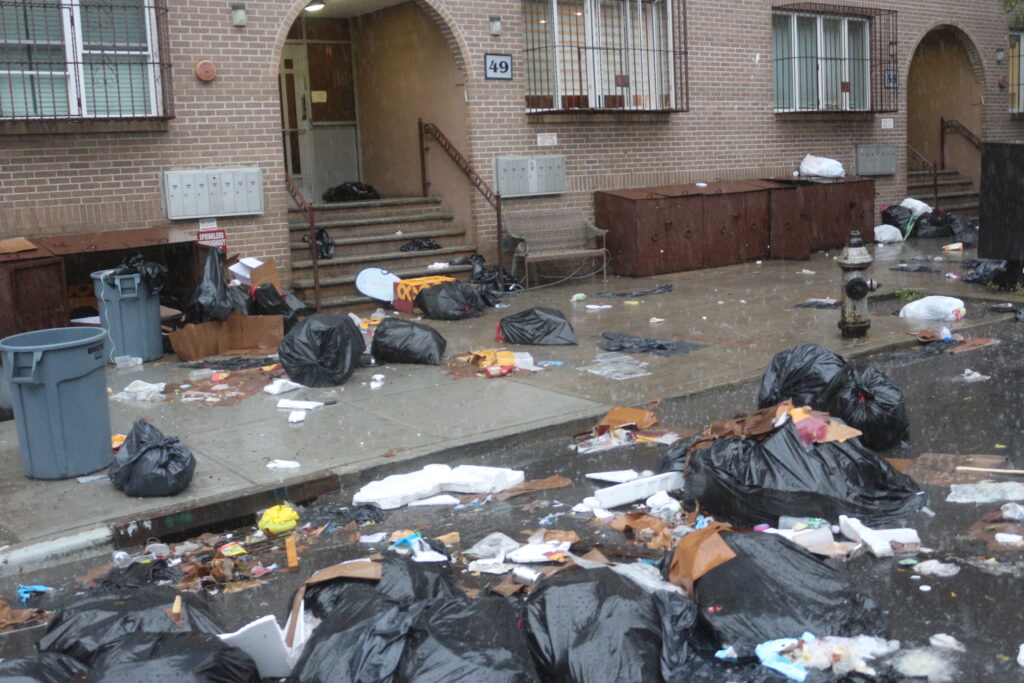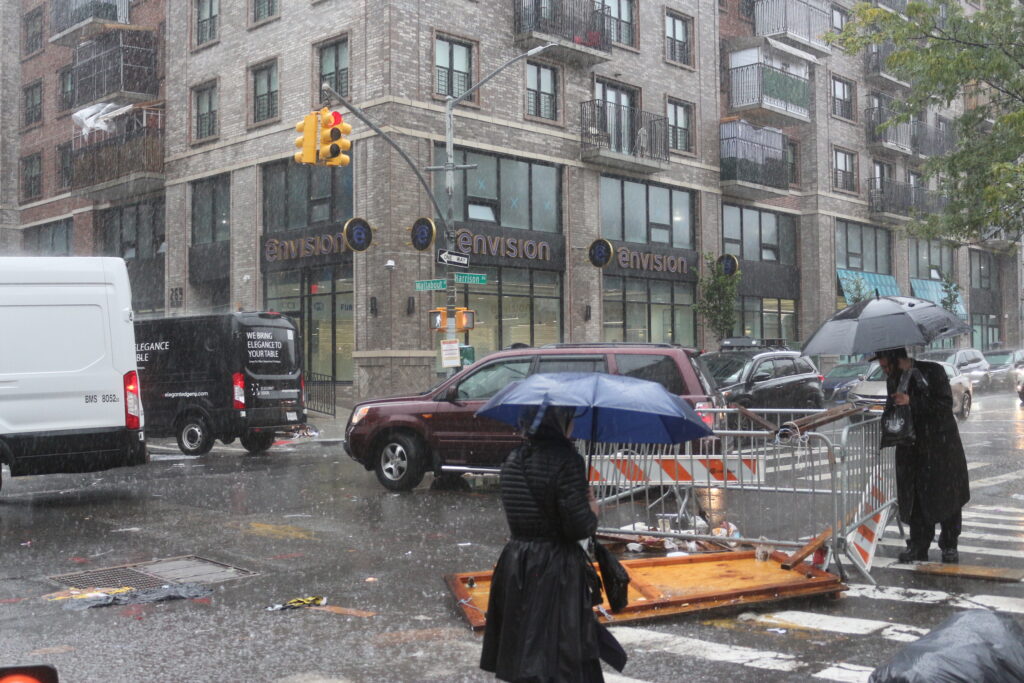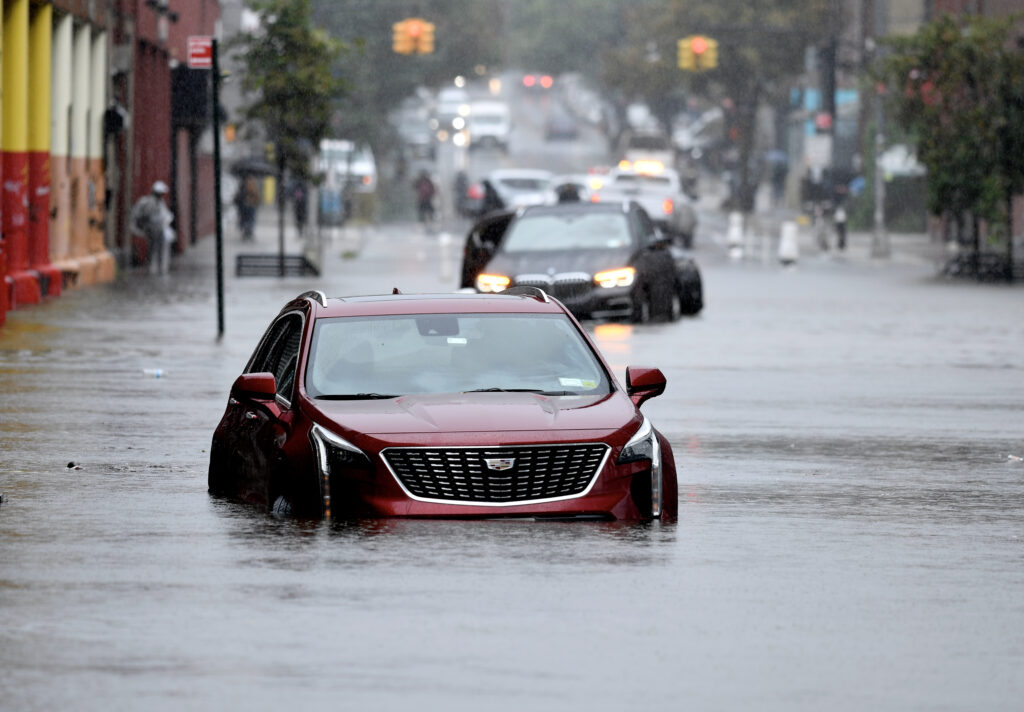By Oona Milliken, Matthew Fischetti and Charlie Finnerty | news@queensledger.com
From Rockaway Beach to Gowanus to Elmhurst, residents of Queens and Brooklyn faced the brunt of last week’s flooding as roadways, homes, subway stations and airports filled with water Friday in what has now been recorded as the worst storm to hit the city since Hurricane Ida.

Trash as a result of the flooding in South Williamsburg. Photo credit: Oona Milliken
Communities worked together all afternoon to clear drains and save neighbors from rising floodwaters but as the outer boroughs return to dry warm weather this week, questions remain about Mayor Eric Adam’s ability to communicate and prepare New York City residents for the historic severe storm.
Water rose to more than three feet high on the corner of Wallabout Street and Harrison Avenue in South Williamsburg on Friday Sept. 29 as New Yorkers across the city dealt with a bout of extreme flooding that prompted a city-wide state of emergency. Anthony Calderon, a Queens-based resident who works at Top Quality Management, a management company on Wallabout St, said he was cleaning up the trash from his office that the water had swept away and spread out across the area. Calderon said when the intersection flooded, he was reminded of storms such as Hurricane Ida, when New York City was shut down under a Flash Flood Emergency for the first time in recorded history and 13 people perished due to the rains.
“Hectic. A lot of rain. It’s just kept coming, kept coming. On Wallabout and Harrison, the flood was coming up here, to your knees at least,” Calderon said. “I was afraid, like ‘Not again, what is this flood?’ I remember a couple of years ago when the hurricanes came, all the subways flooded and Queen’s Boulevard…That’s how I felt, I was like, ‘Are you kidding me? Not again.’”
Mayor Eric Adams was slammed by critics for not giving proper notice of the flooding when his office knew of the dangers on Thursday evening and Governor Hochul had already issued a flash flooding warning for New York City earlier in the day. Adam’s office sent out an email alert at 11 p.m. on Thursday, but did not shut down schools and hosted a public briefing around noon on Friday, hours after the worst rainfall had subsided and the governor had already declared a state of emergency across the city.
The New York City sewer system was originally designed to maintain 1.75 inches of rain per hour, but areas such as the Brooklyn Navy Yard were hit with 2.58 inches of rain per hour, as early as 8:00 a.m. to 9:00 a.m., according to the Mayor’s office.
“And so its no surprise, unfortunately, as a result, that that part of Brooklyn and a couple of other particularly (sic) part of Brooklyn have borne the brunt of this,” said Department of Environmental Protection Commish Rohit T. Aggarwala.
Right before noon, the mayor urged New Yorker’s to stay home or “shelter in place,” while many commuters were already at work. On the Wallabout St. and Harrison Ave intersection, Calderon said the flooding became so bad that community members stepped in and dealt with the problem on their own by removing a manhole cover and letting the storm water drain into the sewer systems.
“People from the community thought of putting gates around, and I had to go do something, and when I came back I could just see a spiral [of water] going down right in the corner. It was amazing. I mean, you could see cars floating,” Calderon said.

Community members gather around the open manhole drain. Photo credit: Oona Milliken
Sandy Spadavecchia was driving his car through the Wallabout and Harrison intersection when the water partially submerged his car, rising up inside and stalling his vehicle. Spadavecchia said he saw a couple of construction workers and Hasidic community members attempt to deal with the problem until someone finally pulled the manhole cover to drain the water. Spadaveccia said he was lucky his car stalled when it did because he could have driven right into the manhole as the water was running into the sewer system.
“There was flooding and the car stalled out in the middle of going through it and that was it,” Spadavecchia said. “In some ways I was lucky because I stalled out three or four feet in front of that open manhole cover, I might have gone into that.”
Spadavecchia said he felt the city could have prevented the piles of trash spread by floodwaters throughout the area had residents been told to keep trash inside during the storm.
“In my personal opinion, they probably should have suspended trash pickup, because I did see a lot of trash bags that hadn’t been picked up clogging [the streets],” Spadaveccia said. “I mean, they knew this was coming so they probably should have told people to keep their trash in for the day.”
Calderon and co-worker Peter Nieves, both at Top Quality Management, were mopping other stores on the street and picking up trash that had been spread during the floods Friday. When asked for a quote on the flooding, Nieves said he just wanted some help and maybe an alcoholic beverage.
“Can I get a beer?” Nieves said.
Across Queens, where many residents are still recovering from the impact of Hurricane Ida, floodwaters closed roads, impacted public transport and filled basements. Cars were overrun with flooding on Grand Central Parkway and in Rosedale, with a number of drivers abandoning their vehicles altogether. Waters engulfed Rockaway Beach, where nearly every home is considered to be at risk of flooding, suspending Long Island Railroad service.
As early as 6 a.m. Friday, travelers at LaGuardia Airport were experiencing inclement weather delays. The Federal Aviation Administration issued a ground stop for the afternoon across the airport, stopping all departing flights due to the flooding and weather in the area, canceling or delaying nearly 40% of all flights Friday. Terminal A, the oldest section of the airport, flooded with several inches of water and shut down 11 a.m. Friday until early Saturday morning. Videos captured travelers trudging through ankle-deep water at gates across the terminal. Ongoing renovations in Terminals B and C have included flood protections that have not yet been implemented in Terminal A.



